Acoustic Privacy
Speech Privacy Potential
At 30 dBA, the masking sound is barely audible and yet provides the minimum necessary to accurately plan the remaining elements of the acoustical design. However, there are significant opportunities for further value engineering. As partition attenuation increases, for each decibel reduction there is an increase in speech privacy levels. Mathematically, the same can be achieved by raising the background sound level by a decibel.
When preparing “Sound & Vibration 2.0: Design Guidelines for Health Care Facilities”—the companion document to the Facility Guidelines Institute’s (FGI) “2014 Guidelines for Design and Construction of Hospitals and Outpatient Facilities”—acousticians developed a formula that provides a predictive model for this approach. Basically, to “achieve confidential speech privacy, the sum of the composite STC and the A-weighted background noise level shall be at least 75,” or STCc + dBA ≥ 75. Some refer to this formula as speech privacy potential (SPP). Though developed with a particular type of facility in mind, most people expect conversations occurring within closed rooms to remain private, making SPP more broadly applicable. Note that STCc includes the negative impact on acoustic performance when elements such as doors and windows are added to the partition.
If speech privacy equals STCc + 30 dBA ≥ 75, then for every 1 dBA increase in the background sound level, it is possible to reduce STCc by one point and achieve the equivalent level of speech privacy. Were the background sound to be increased from 30 dBA to 35 dBA, for instance, construction costs for partition types would start to drop significantly because the STCc could be reduced by five points. Again, 30 dBA—and, indeed, even 35 dBA—is well below typical masking levels in closed rooms. Usually, they are set to between 40 and 45 dBA in such spaces.
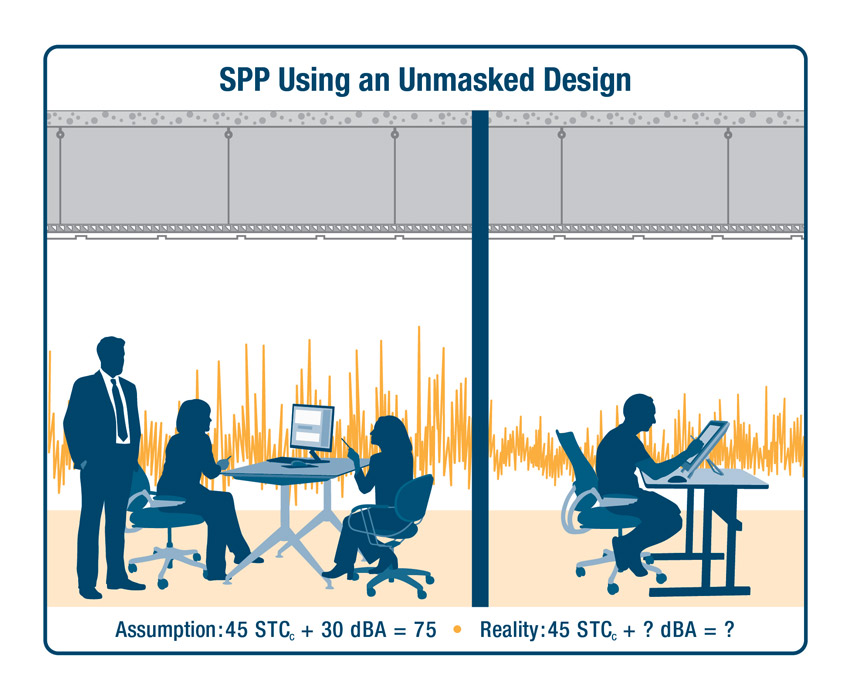
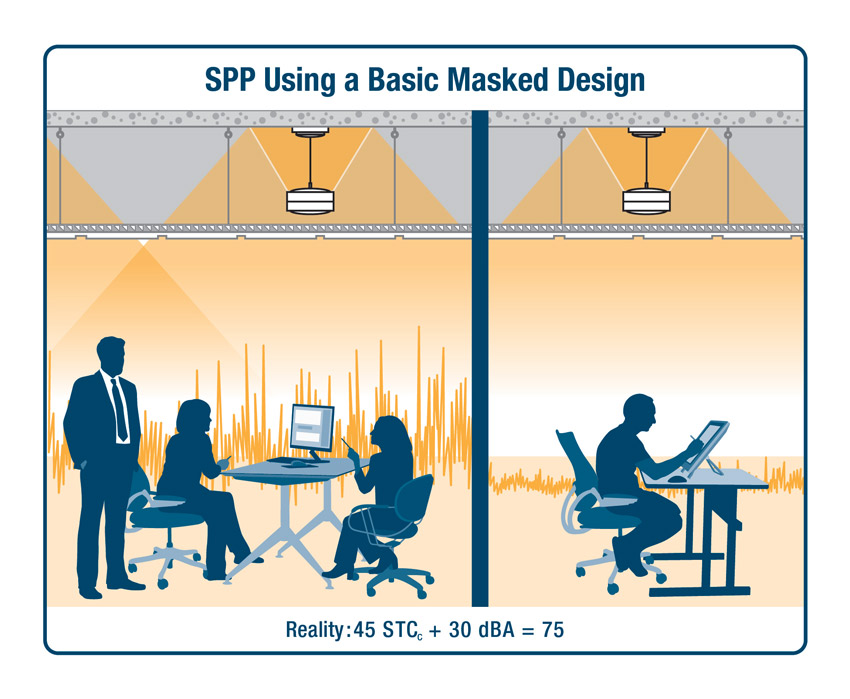
Images courtesy of KR Moeller Associates Ltd.
Top: A design that does not feature sound masking, but rather relies on HVAC to provide an assumed minimum background sound level leads to over-specification of the room’s physical structure, while nonetheless leaving its actual acoustic performance up to chance.
Bottom: A design that utilizes sound masking to establish a known minimum background sound level—even as low as 30 dBA—as well as a spectrum or ‘curve’ designed for speech privacy eliminates the variability of HVAC sound, allowing acoustic goals to be more reliably achieved with the stated STCc.
Sound masking can also be used in combination with walls or demountable partitions built to a suitably ceiling attenuation class (CAC)-rated suspended ceiling in order to provide a cost-effective and more flexible alternative to deck-to-deck construction. For example, a major American health-care provider changed its construction standards for medical office buildings away from deck-to-deck construction. After significant testing of mockup facilities, the company determined that it achieved as good or better speech privacy with ceiling-height walls and sound masking. It reported cost savings of hundreds of thousands of dollars for a project of just over 30,000 square feet (2,787 square meters).
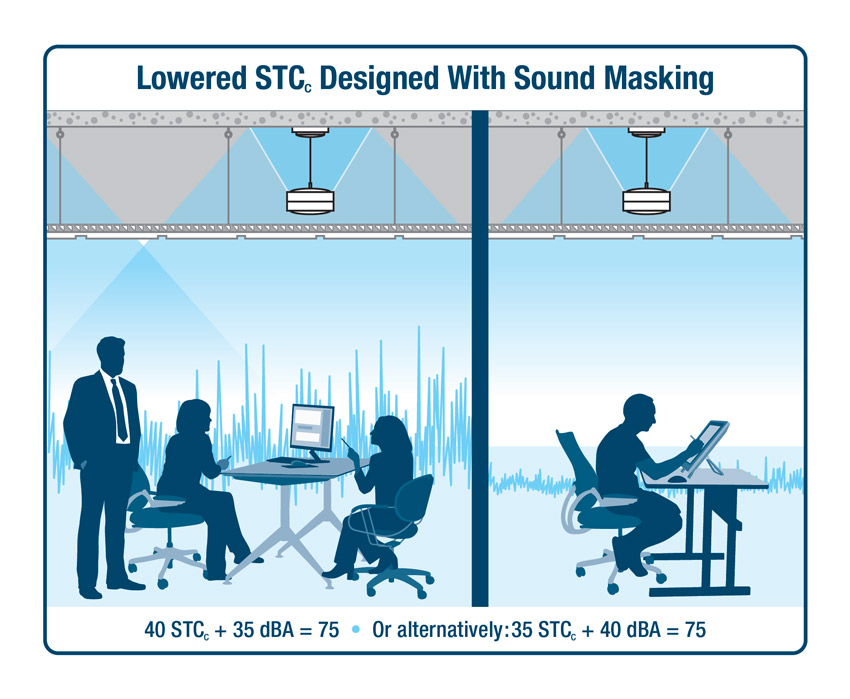
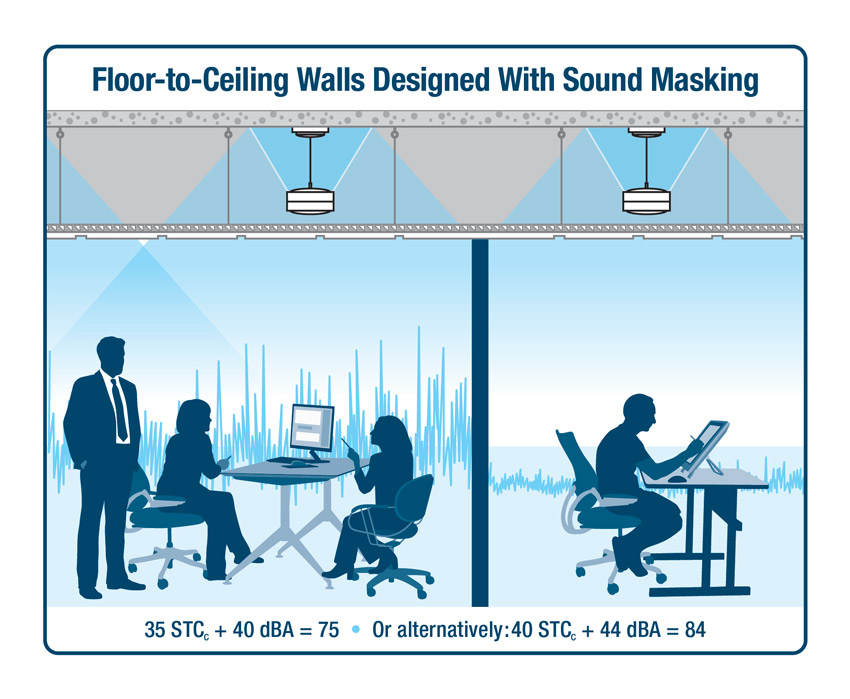
Images courtesy of KR Moeller Associates Ltd.
Top: If the background sound level is set to 35 rather than 30 dBA, STCc can be lowered to 40. Alternatively, using a still moderate level of 40 dBA permits STCc as low as 35 while maintaining a speech privacy potential (SPP) of 75. In fact, value can still be derived by the most cautious of specifiers, even if they take only half the increment in background sound as an STCc reduction. For example, with masking at 40 dBA, rather than drop STCc from 45 to 35, an STCc of 40 plus masking at 40 dBA yields an SPP of 80.
Bottom: Further value engineering and site flexibility can be achieved by specifying room construction with walls built to the suspended ceiling rather than structure. With STCc at 35 and the masking level reliably set to 40 dBA, SPP is 75. If the STCc is increased to 40 and the masking level is raised to 44 dBA, SPP is 84.
There are some cases where one may want to implement both deck-to-deck construction and sound masking; for example, in spaces where raised voices or high-volume media will be used, as well as in areas with high security needs. Also, if the facility features an open ceiling, full-height walls are recommended to ensure some degree of inter-zone isolation.
Meeting the Curve
It should be noted that this type of integrated acoustic design is only viable when the minimum background sound level is precisely generated and consistently delivered.
ASTM acknowledges that variations as small as 2 dBA can significantly influence speech privacy, while other studies indicate that, regardless of design, even a single dBA affects comprehension by up to 10 percent and, in almost every situation, impacts AI by 0.0333. Variations in spectral quality can have similarly negative effects. Therefore, it is incumbent upon those responsible for acoustic design and planning to ensure that the sound-masking system is designed and implemented with due consideration for these stringent requirements.
Unlike ‘white noise’ or ‘pink noise’—terms often, but mistakenly, used—sound masking follows a nonlinear curve specifically designed to balance acoustic control and occupant comfort. A successful implementation involves achieving both goals. No sound-masking system can accomplish these objectives ‘out of the box.’ Regardless of its design, where its loudspeakers are located, or whether they face upward or downward, the sound changes as it interacts with various elements across the facility’s interior. In order to meet the curve, the sound must be tuned.
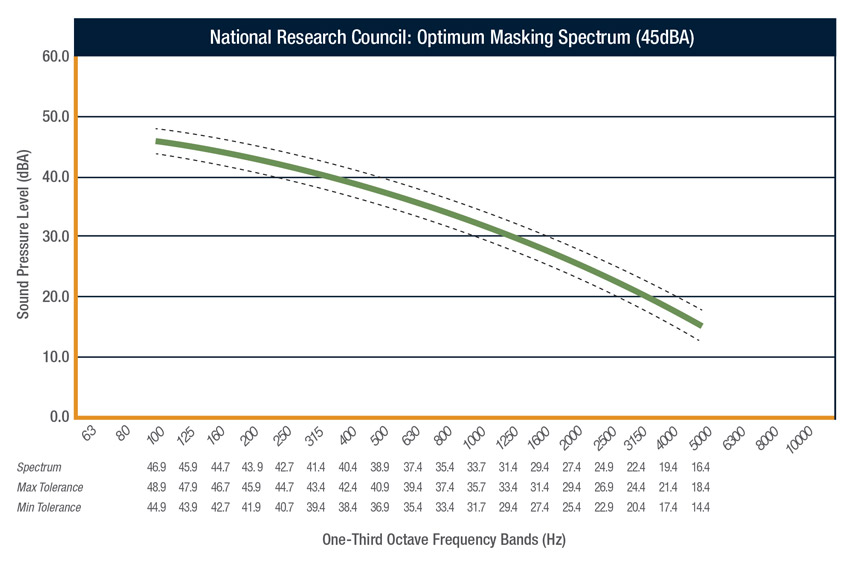
Image courtesy of KR Moeller Associates Ltd.
Shown are the National Research Council’s (NRC) optimum masking spectrum, as well as one-third octave band tolerances of ±2 dBA.
Tuning should be handled after the ceilings and furnishings are in place. Because activity and conversation prevent accurate measurement, it should also be done prior to occupation of the facility or after hours. The exact method varies by product, but basically, an acoustician or trained technician measures the sound at ear height (i.e., the level at which occupants experience its effects), examines the results, and adjusts the system’s volume and frequency settings accordingly. These steps are repeated until they curve is met at each tuning location.
Because it is impossible to achieve perfection in every location, a masking specification will also include a ‘tolerance’ indicating how much the sound is allowed to deviate from the target curve across the treated space. However, as noted above, it is vital to keep this value to a minimum. Outdated specifications might allow for a wide tolerance of ±2 dBA (i.e., giving an overall range of 4 dBA across the space), resulting in a 40 percent performance loss in unpredictable locations across the facility, as indicated by Graph 2.
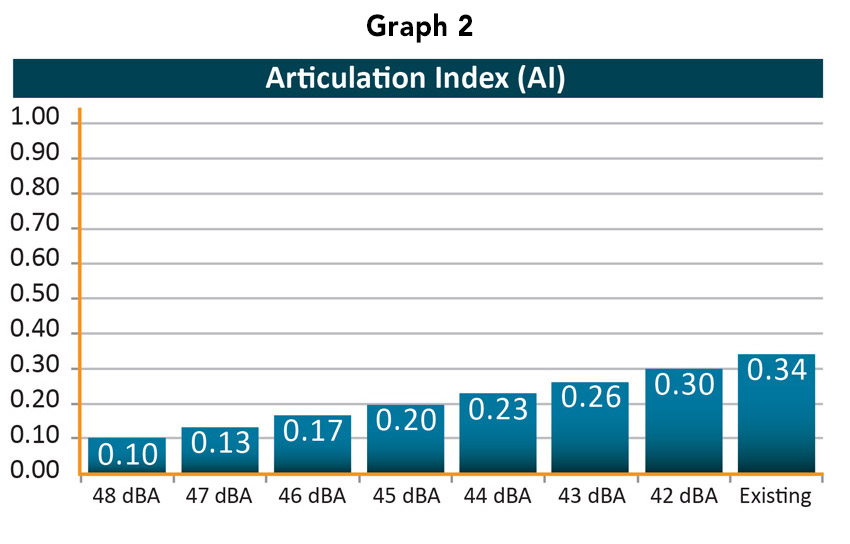
Image courtesy of KR Moeller Associates Ltd.
AI tests reveal the importance of properly tuning the sound masking in order to prevent large (i.e., greater than 1 dBA) variations in coverage across the space.
When designed with small zones of one to three loudspeakers offering fine volume (i.e., 0.5 dBA) and frequency (i.e., 1/3 octave) control, a computer-tuned networked sound-masking architecture can provide consistency in the overall masking level not exceeding ±0.5 dBA (i.e., 1 dBA overall), yielding much better results than earlier architectures developed in the 1960s and 70s.









